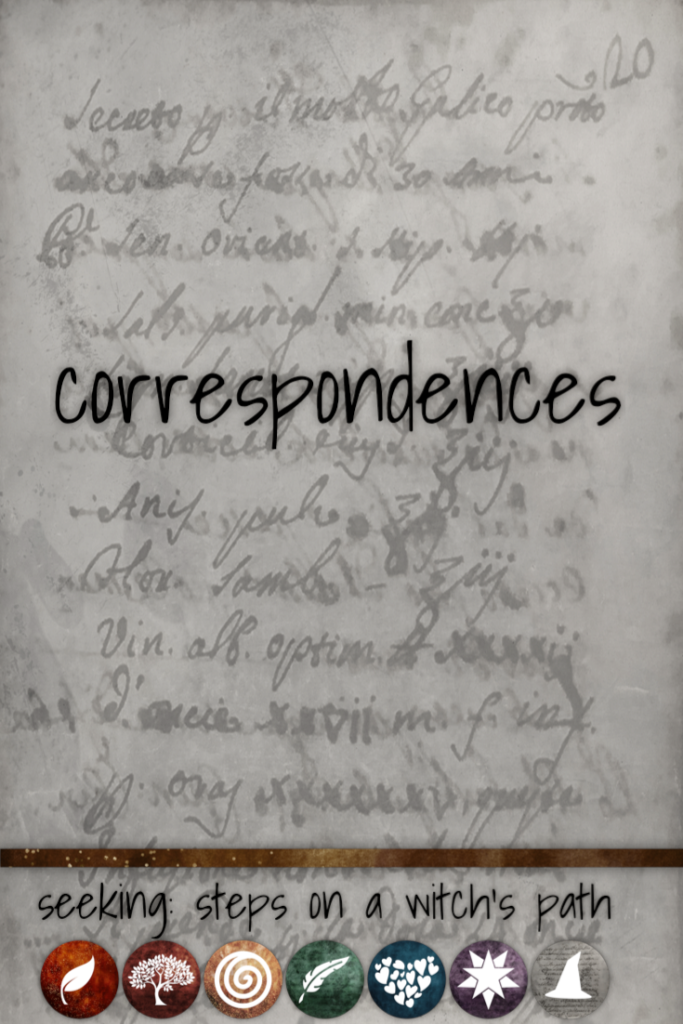As you read various books and websites, you’ll start seeing (if you haven’t already) long lists of how this plant is associated with this planet, or that deity, or that day of the week, or that concept (love, prosperity, healing, whatever.) These are called ‘correspondences’.

One magical theory is that it is easier to reach out and affect (change) the world if we use something that is connected to what we’re trying to do. We can’t reach out directly and touch everyone who might give us money, for example – but if there’s a herb, or stone, or whatever that’s closely associated with that thing, we can go and do something with that, instead.
Types
Correspondences can apply to all sorts of things.
- colors
- shapes
- days of the week
- time of day
- astrological signs
- herbs
- stones and crystals
- parts of the body
- sounds
- types of music
- symbols
- food and drink
- and much more.
Do you need correspondences?
Correspondences can be a very helpful tool, but there are plenty of ways to do magic and ritual that don’t rely on them (or don’t rely on anything particularly complicated.)
I sometimes think about magic as one of those little tilting mazes you see as children’s toys, where you’re trying to guide a ball through a maze and into the exit.
Each correspondence you use (within reason: one or two or five will usually show much more effect than a dozen) helps make that easier to do. It’s easier to tilt more precisely in the direction you want. But if you want, and you have patience and a little skill, you can probably get it there all by yourself.
Jason Miller mentions in some of his work that correspondences can also help make the items you’re using ‘sticky’ for magic – it makes it easier to anchor the magic you’re doing in and to an object.
As I just mentioned, you also don’t need to use every correspondence possible. (And in fact, chances are that some of them won’t work very well together.) You can decide which ones speak most clearly to your conscious and subconscious minds, or which ones you find most pleasing, or which ones are most practical for you, and use those.
I personally use a lot of colour, shape, and symbol correspondences, some herbal ones, a few stone ones, and some other things like scent.
For timing correspondences, I mostly focus on the days of the week, and sometimes the planetary hour. I care more for major ritual events like initiations or specific high-value rituals like that.
Where do they come from?
Correspondences have been developed from a wide range of sources. In some cases, like the core parts of astrological timing, they may have an incredibly ancient history. In other cases, they may be very recent. Often, they come from people having the same basic experience with a correspondence over time. (For example, lots of people experience hematite as being a very grounding stone.)
In some cases, they come from other properties of that substance. Many herbs have medicinal uses, and as you learn about the magical uses, you’ll often find that the magical and medicinal uses are somehow linked. For example, many spices like cinnamon, nutmeg, and cardamon, are considered warming herbs (in an energetic and healing sense), and they’re also considered herbs that help things happen magically.
Sometimes a relationship comes from history. Those spices were originally rare and expensive in medieval and Renaissance Europe, so they’re also associated with prosperity and abundance. However, a little of them goes a long way, so it’s a prosperity and abundance that’s more within our reach (rather than something like a nugget of gold.)
What happens when different lists disagree?
You’ll definitely find that lists sometimes or often disagree. Sometimes that’s because people have different experiences. Sometimes, it’s because people experience a thing differently in different places.
For example, in the US, it’s common to connect the color green to abundance and prosperity. Green is certainly associated with growth, but in the US, it’s also the color of money. People in other countries, whose currency is a different color, won’t have that particular association.
Developing your own lists
I suggest that you take time to develop your own correspondence lists. As you learn, take note of which correspondences make sense to you – don’t just copy lists down and use them. For example, you might learn why each day of the week has the name it does historically, and then think about whether that’s a correspondence you want to use regularly.
You might pick one or two herbs to study each month, and get to know them in a variety of ways (find a living plant in a greenhouse or your garden, use it in cooking if it’s a culinary herb, try it as an incense, etc.) and then also consider the correspondences.

Revised July 22, 2020. Reformatted November 2020.



